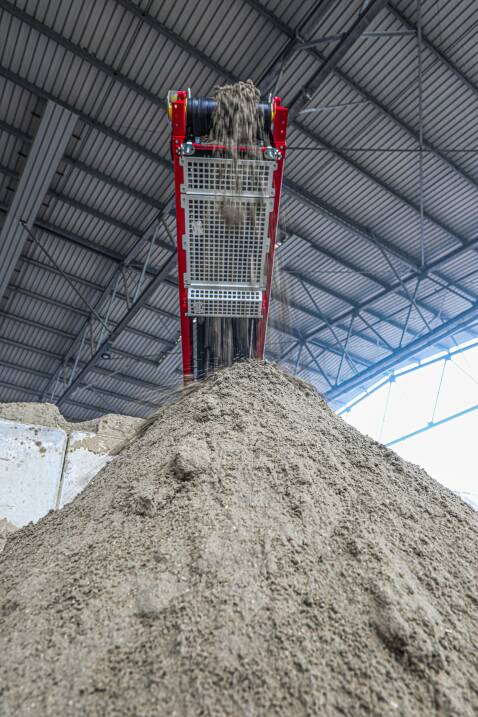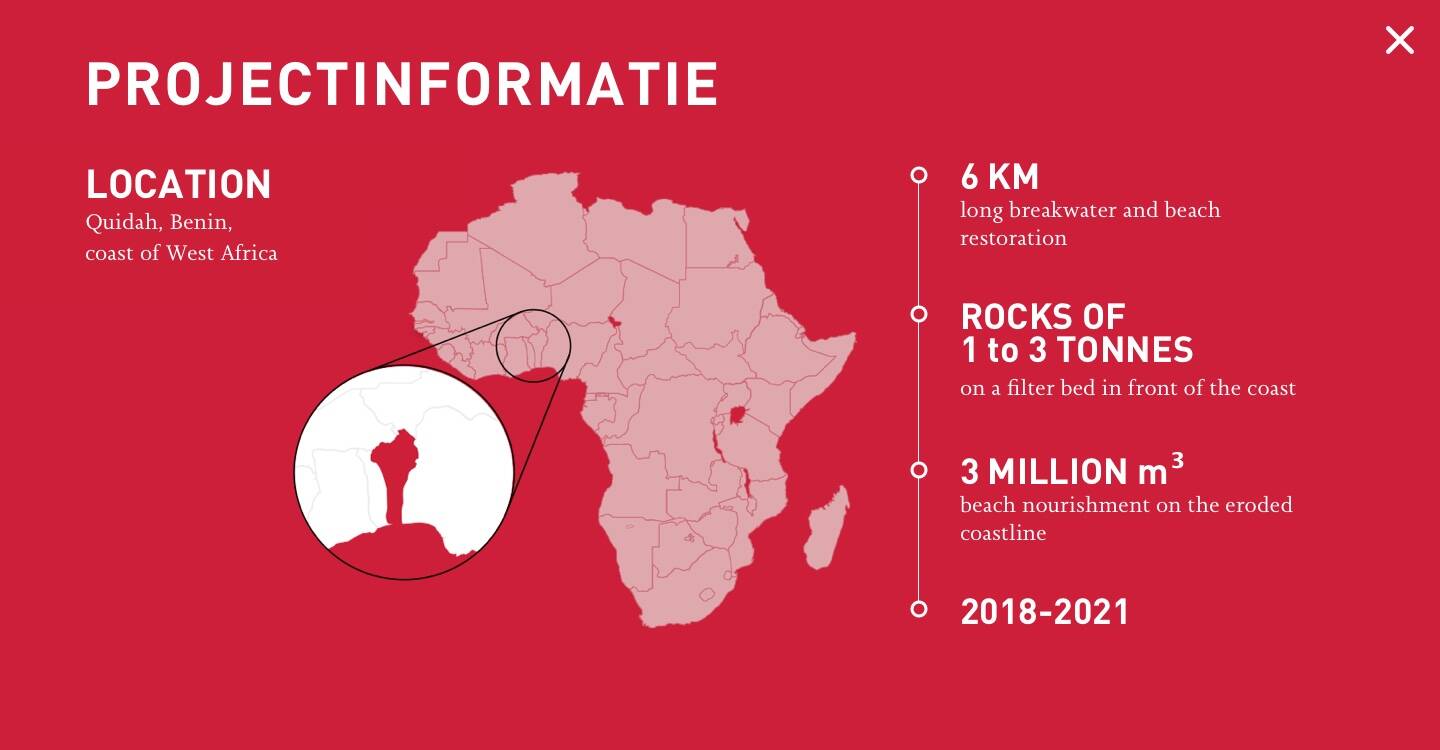



Think of immobilisation, a technique to prevent PFAS from spreading to groundwater. With soil flushing, we extract PFAS from the soil by flushing it repeatedly with water and biodegradable additives. Both techniques can be done on site, reducing our carbon footprint and optimising cost-effectiveness. To reduce PFAS concentrations in process water and groundwater, we are investigating foaming.
PFAS is thereby attracted to a foam and separated from the main water stream. However, the ultimate goal remains to destroy PFAS and break its organic bond. An optimised destruction technique therefore holds an important place in our research. While some of these techniques are still in research phase, others are now ready to be rolled out in pilot projects.
Depending on the composition and PFAS concentrations of certain soils, soil washing may not be the most applicable technique. Our R&D and Innovation team, together with universities and other knowledge institutes, is constantly looking into new methods.
Taking care of nature is not only what we do, but is also in how we do it. In the first place, no water gets lost in the soil washing process. It is constantly treated and reused in next washing cycles. In addition, all our soil washing installations are semi-mobile and can therefore be deployed on site, eliminating transport and reducing our carbon footprint.
PFAS contamination does not only occur in soil. Groundwater often contains (too) high concentrations too. To tackle this, Envisan has more than 10 special equipped mobile water treatment plants to capture the PFAS.
The PFAS treatment plant in Ghent is our newest and largest one of three. In a previous Focus edition, we put the spotlight on our plant in Monsin. With all three plants combined, we are able to make up to 2,000 tonnes of soil PFAS-free every day.


Jurgen De Bruyne
Operations Manager Plants
Emma Vanderveken
Project Engineer R&D









The current go-to technique to remediate PFAS contaminated soils is soil washing. By adding special features to detach PFAS from the soil and introducing advanced water treatment, we perfected this soil washing process. In mid-2023, we commissioned a new plant in Ghent to apply this technique on a large scale.
PFAS are called ‘forever chemicals’ for a reason. This broad group of chemicals all share the carbon-fluorine bond, one of the strongest bonds in organic chemistry. This gives them unique properties: they are resistant to heat, moisture and stains, which is why they were used for the production of all kinds of everyday items for many years. But there’s a flip side of the coin. PFAS barely degrades in the environment and chronic exposure, even to low levels, can lead to harmful effects, for both humans and nature.
In our daily lives, a hidden problem lingers, infiltrating the air we breathe, the water we drink, and even the food we consume. This concern goes by the acronym PFAS, and its pervasive presence has become a growing concern for scientists, environmentalists, and the general public alike. Although the danger of PFAS only came to public attention in recent years, Envisan, the environmental division of Jan De Nul, has been conducting research on how to treat PFAS contaminants for years. The result? We are applying techniques on a large scale today to remediate PFAS in soil and water – with commendable results – and have other ones in the pipeline to throw into the PFAS fight in the near future.






Think of immobilisation, a technique to prevent PFAS from spreading to groundwater. With soil flushing, we extract PFAS from the soil by flushing it repeatedly with water and biodegradable additives. Both techniques can be done on site, reducing our carbon footprint and optimising cost-effectiveness. To reduce PFAS concentrations in process water and groundwater, we are investigating foaming.
PFAS is thereby attracted to a foam and separated from the main water stream. However, the ultimate goal remains to destroy PFAS and break its organic bond. An optimised destruction technique therefore holds an important place in our research. While some of these techniques are still in research phase, others are now ready to be rolled out in pilot projects.

Depending on the composition and PFAS concentrations of certain soils, soil washing may not be the most applicable technique. Our R&D and Innovation team, together with universities and other knowledge institutes, is constantly looking into new methods.
Taking care of nature is not only what we do, but is also in how we do it. In the first place, no water gets lost in the soil washing process. It is constantly treated and reused in next washing cycles. In addition, all our soil washing installations are semi-mobile and can therefore be deployed on site, eliminating transport and reducing our carbon footprint.
PFAS contamination does not only occur in soil. Groundwater often contains (too) high concentrations too. To tackle this, Envisan has more than 10 special equipped mobile water treatment plants to capture the PFAS.
The PFAS treatment plant in Ghent is our newest and largest one of three. In a previous Focus edition, we put the spotlight on our plant in Monsin. With all three plants combined, we are able to make up to 2,000 tonnes of soil PFAS-free every day.





Emma Vanderveken
Project Engineer R&D
Jurgen De Bruyne
Operations Manager Plants
The current go-to technique to remediate PFAS contaminated soils is soil washing. By adding special features to detach PFAS from the soil and introducing advanced water treatment, we perfected this soil washing process. In mid-2023, we commissioned a new plant in Ghent to apply this technique on a large scale.



PFAS are called ‘forever chemicals’ for a reason. This broad group of chemicals all share the carbon-fluorine bond, one of the strongest bonds in organic chemistry. This gives them unique properties: they are resistant to heat, moisture and stains, which is why they were used for the production of all kinds of everyday items for many years. But there’s a flip side of the coin. PFAS barely degrades in the environment and chronic exposure, even to low levels, can lead to harmful effects, for both humans and nature.
In our daily lives, a hidden problem lingers, infiltrating the air we breathe, the water we drink, and even the food we consume. This concern goes by the acronym PFAS, and its pervasive presence has become a growing concern for scientists, environmentalists, and the general public alike. Although the danger of PFAS only came to public attention in recent years, Envisan, the environmental division of Jan De Nul, has been conducting research on how to treat PFAS contaminants for years. The result? We are applying techniques on a large scale today to remediate PFAS in soil and water – with commendable results – and have other ones in the pipeline to throw into the PFAS fight in the near future.








































